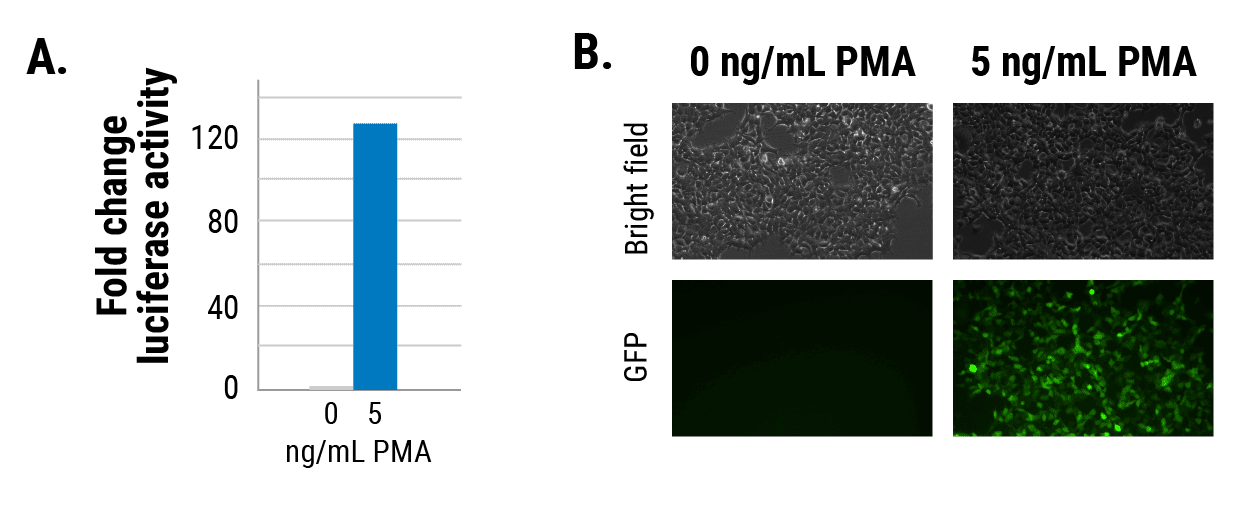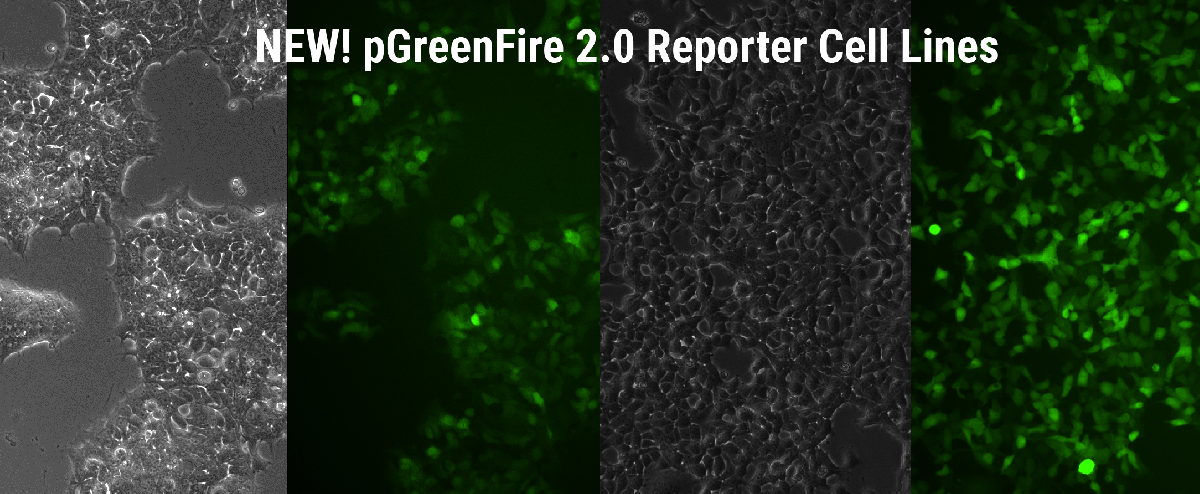NEW! pGreenFire 2.0 signalling pathway reporters as stable cell lines
NEW PRODUCT ALERT!
SBI is excited to announce the launch of the stable cell line format of our pGreenFire 2.0 signalling pathway reporters! Last year, we launched the pGreenFire 2.0 signalling pathway reporter lentivectors, which upgraded our popular pGreenFire lentivector series in several ways, including by replacing the conventional luciferase with red firefly luciferase. With red firefly luciferase, you can achieve greater sensitivity in vivo and also have the ability to perform dual-spectral luciferase assays. We've now expanded the pGreenFire 2.0 family with two stable cell lines—AP-1 and TCF/LEF reporter cell lines—for ready-to-use insights into signal transduction during a range of cellular processes, including differentiation, apoptosis, and inflammatory responses such as the response to viral infection.
NOTE: We have additional pGreenFire 2.0 stable cell lines in development so keep an eye on your inbox for more new product announcements. However, if you need a stable cell line now and don't see what you're looking for, our Custom Services team can build the cell line for you—just contact us with your project needs and we can send you a quote.
Understanding the pGreenFire cassette
If you're not familiar with our pGreenFire reporters, both 1.0 and 2.0 share a similar core functionality—transcriptional response elements (TREs) are placed upstream of a minimal CMV promoter (mCMV) and the pGreenFire luciferase-T2A-GFP co-expression cassette (Figure 1).

Figure 1. pGreenFire 2.0 reporter cassette
In the absence of transcriptional activation, the mCMV promoter has negligible activity, resulting in little- to no- luciferase activity or GFP fluorescence (Figure 2). However, upon activation of the TREs, such as in response to the addition of an inducer, the TREs plus the mCMV promoter drive expression of both luciferase and GFP in a dose-dependent fashion (Figure 2). The result is the ability to quantitatively measure pathway activation using luciferase activity or while imaging using GFP.

Figure 2. The pGreenFire 2.0 AP-1 clonal 293T reporter cell line efficiently and quantitatively reports on AP-1 activity. Luciferase activity (A) and GFP intensity (B) both increase in response to PMA, an AP-1 inducer.
Get your studies up-and-running quickly with ready-to-use reporter cell lines
SBI streamlines your studies with a range of ready-to-use pGreenFire reporter cell lines:
[table “26” not found /]| Cat. # | Product Name | TRE |
|---|---|---|
Stable cell lines based on pGreenFire 1.0 |
||
| NF-κB/Jurkat/GFP Transcriptional Reporter Cell Line | NF-κB | |
| NF-κB/293/GFP-Luc Transcriptional Reporter Cell Line | NF-κB | |
| pGF-p53-mCMV-EF1α-Puro (HT1080 stable cell line)) | p53 | |
| pGF-AP1-mCMV-EF1α-Puro (293 stable cell line) | AP-1 | |
| pGF-CREB-mCMV-EF1α-Puro (293 stable cell line) | CREB | |
| pGF-SMAD2/3/4-mCMV-EF1α-Puro (293 stable cell line) | SMAD2/3/4 | |
| pGF-EGR1-mCMV-EF1α-Puro (293 stable cell line) | EGR1 | |
| pGreenFire1-LXRE in SREBP1c (HepG2 cell line) | LXRE in SREBP1c | |
| pGreenFire1- PPRE (HepG2 cell line) | PPRE | |
| pGreenFire1-LXRE in LXRα (HepG2 cell line) | LXRE in LXRα | |
| pGreenFire1-LXRE in ApoA1 (HepG2 cell line) | LXRE in ApoA1 | |
| pGreenFire1-LXRE in Cyp7A1 (HepG2 cell line) | LXRE in Cyp7A1 | |
| pGreenFire1-LXRE in ABCA1 (HepG2 cell line) | LXRE in ABCA1 | |
| pGreenFire1-LXRE in ABCG1 (HepG2 cell line) | LXRE in ABCG1 | |
| pGreenFire1-LXRE in ApoE (HepG2 cell line) | LXRE in ApoE | |
| pGreenFire1-LXRE in CETP (HepG2 cell line) | LXRE in CETP | |


